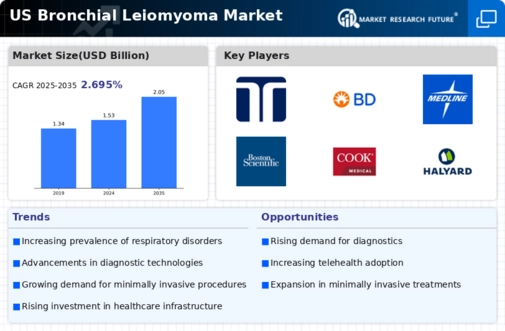Rising Awareness of Rare Tumors
The bronchial leiomyoma market appears to be positively impacted by the rising awareness of rare tumors among both healthcare professionals and the general public. Educational initiatives and advocacy efforts are increasing knowledge about the symptoms and treatment options for rare conditions, including bronchial leiomyomas. This heightened awareness may lead to earlier diagnosis and treatment, as patients and providers become more attuned to the signs of these tumors. Furthermore, organizations dedicated to rare diseases are gaining traction, which could foster a supportive environment for research and development in the bronchial leiomyoma market. As awareness continues to grow, the market may experience an uptick in patient referrals and treatment uptake.
Increased Focus on Personalized Medicine
The bronchial leiomyoma market is likely to be influenced by the growing emphasis on personalized medicine in the US healthcare landscape. Tailoring treatment plans to individual patient profiles, including genetic and molecular characteristics, is becoming more prevalent. This approach may enhance the effectiveness of therapies for bronchial leiomyomas, as clinicians can select the most appropriate interventions based on specific patient needs. The National Institutes of Health has reported a significant increase in funding for personalized medicine research, which could lead to innovative treatment options for bronchial leiomyomas. As personalized approaches gain traction, the market may see a rise in demand for targeted therapies, thereby driving growth.
Rising Incidence of Respiratory Disorders
The bronchial leiomyoma market is likely to experience growth due to the increasing incidence of respiratory disorders in the US. Conditions such as asthma and chronic obstructive pulmonary disease (COPD) are becoming more prevalent, leading to heightened awareness and diagnosis of related conditions, including bronchial leiomyomas. According to the CDC, approximately 25 million Americans have asthma, which may contribute to the identification of bronchial leiomyomas during diagnostic procedures. This trend suggests that healthcare providers are more vigilant in screening for such tumors, thereby potentially increasing the patient population requiring treatment. As the healthcare system adapts to these rising cases, the bronchial leiomyoma market could see a corresponding increase in demand for therapeutic interventions.
Growing Investment in Healthcare Infrastructure
The bronchial leiomyoma market may benefit from the growing investment in healthcare infrastructure across the US. With an increasing focus on enhancing healthcare facilities and services, there is a corresponding rise in the availability of specialized treatment centers for respiratory conditions. This expansion is likely to improve access to care for patients with bronchial leiomyomas, as more facilities are equipped to diagnose and treat these tumors. According to the American Hospital Association, healthcare spending in the US is projected to reach $6 trillion by 2027, indicating a robust investment climate. Such developments could lead to a more favorable environment for the bronchial leiomyoma market, as patients gain better access to necessary treatments.
Technological Innovations in Diagnostic Imaging
Advancements in diagnostic imaging technologies are poised to significantly impact the bronchial leiomyoma market. Techniques such as high-resolution computed tomography (CT) and magnetic resonance imaging (MRI) have improved the detection rates of bronchial leiomyomas, allowing for earlier diagnosis and intervention. The integration of artificial intelligence in imaging analysis further enhances the accuracy of identifying these tumors. As a result, healthcare providers are likely to diagnose more cases, leading to an increased demand for treatment options. The market for bronchial leiomyoma is expected to benefit from these innovations, as they facilitate timely and effective management of the condition, ultimately improving patient outcomes.



















Leave a Comment